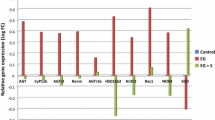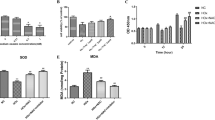Abstract
Urinary excretion of 8-hydroxydeoxyguanosine (8-OHdG), a marker of oxidative DNA damage, is significantly higher in nephrolithiasis patients than in healthy individuals, indicating that these patients have higher degree of oxidative stress. In the present study, we investigated 8-OHdG expression in renal biopsies of patients with nephrolithiasis and in renal tubular cells (HK-2 cells) exposed to calcium oxalate monohydrate (COM). We performed immunohistochemical staining for 8-OHdG in renal biopsies adjacent stones obtained from 28 patients with nephrolithiasis. Controls were noncancerous renal tissues from nephrectomies of patients with renal cancer. 8-OHdG was overexpressed in the nucleus of renal tubular cells in patients with nephrolithiasis compared with controls. Only one nephrolithiasis biopsy was negative for 8-OHdG, whereas in 19 cases 8-OHdG was highly expressed. The level of expression of 8-OHdG among patients with calcium oxalate (mostly mixed with calcium phosphate) and uric acid stones was not significantly different. Increased leukocyte infiltration was observed in renal tissues from patients with nephrolithiasis. Exposure of HK-2 cells to COM caused increased intracellular reactive oxygen species and nuclear expression of 8-OHdG. To our knowledge, this is the first report of increased 8-OHdG expression in renal tubular cells of patients with nephrolithiasis. In vitro, COM crystals were capable of inducing oxidative damage of DNA in the proximal renal tubular cells.





Similar content being viewed by others
References
Khan SR (2013) Reactive oxygen species as the molecular modulators of calcium oxalate kidney stone formation: evidence from clinical and experimental investigations. J Urol 189:803–811
Khand FD, Gordge MP, Robertson WG, Noronha-Dutra AA, Hothersall JS (2002) Mitochondrial superoxide production during oxalate-mediated oxidative stress in renal epithelial cells. Free Radic Biol Med 32:1339–1350
Khan SR (2005) Hyperoxaluria-induced oxidative stress and antioxidants for renal protection. Urol Res 33:349–357
Byer K, Khan SR (2005) Citrate provides protection against oxalate and calcium oxalate crystal induced oxidative damage to renal epithelium. J Urol 173:640–646
Thamilselvan S, Khan SR, Menon M (2003) Oxalate and calcium oxalate mediated free radical toxicity in renal epithelial cells: effect of antioxidants. Urol Res 31:3–9
Escobar C, Byer KJ, Khaskheli H, Khan SR (2008) Apatite induced renal epithelial injury: insight into the pathogenesis of kidney stones. J Urol 180:379–387
Huang HS, Ma MC, Chen J, Chen CF (2002) Changes in the oxidant-antioxidant balance in the kidney of rats with nephrolithiasis induced by ethylene glycol. J Urol 167:2584–2593
Itoh Y, Yasui T, Okada A, Tozawa K, Hayashi Y, Kohri K (2005) Preventive effects of green tea on renal stone formation and the role of oxidative stress in nephrolithiasis. J Urol 173:271–275
Pragasam V, Kalaiselvi P, Sumitra K, Srinivasan S, Varalakshmi P (2005) Counteraction of oxalate induced nitrosative stress by supplementation of l-arginine, a potent antilithic agent. Clin Chim Acta 354:159–166
Huang HS, Chen J, Chen CF, Ma MC (2006) Vitamin E attenuates crystal formation in rat kidneys: roles of renal tubular cell death and crystallization inhibitors. Kidney Int 70:699–710
Park HK, Jeong BC, Sung MK, Park MY, Choi EY, Kim BS, Kim HH, Kim JI (2008) Reduction of oxidative stress in cultured renal tubular cells and preventive effects on renal stone formation by the bioflavonoid quercetin. J Urol 179:1620–1626
Huang HS, Ma MC, Chen CF, Chen J (2003) Lipid peroxidation and its correlations with urinary levels of oxalate, citric acid, and osteopontin in patients with renal calcium oxalate stones. Urology 62:1123–1128
Tungsanga K, Sriboonlue P, Futrakul P, Yachantha C, Tosukhowong P (2005) Renal tubular cell damage and oxidative stress in renal stone patients and the effect of potassium citrate treatment. Urol Res 33:65–69
Boonla C, Wunsuwan R, Tungsanga K, Tosukhowong P (2007) Urinary 8-hydroxydeoxyguanosine is elevated in patients with nephrolithiasis. Urol Res 35:185–191
Boonla C, Youngjermchan P, Pumpaisanchai S, Tungsanga K, Tosukhowong P (2011) Lithogenic activity and clinical relevance of lipids extracted from urines and stones of nephrolithiasis patients. Urol Res 39:9–19
Huang XB, Ito F, Nakazawa H, Toma H (1999) Increased expression of 8-hydroxydeoxyguanosine in acquired cystic disease of the kidney. Nephron 81:458–459
Tsai JP, Liou JH, Yeh KT, Tai HC, Cheng YW, Chang HR (2011) Intensity of cytosol expression of 8-OHdG in normal renal tubules is associated with the severity of renal fibrosis. Swiss Med Wkly 141:w13268
Wang H, Joseph JA (1999) Quantifying cellular oxidative stress by dichlorofluorescein assay using microplate reader. Free Radic Biol Med 27:612–616
Yao X, Zhong L (2005) Genotoxic risk and oxidative DNA damage in HepG2 cells exposed to perfluorooctanoic acid. Mutat Res 587:38–44
Khan SR (2004) Crystal-induced inflammation of the kidneys: results from human studies, animal models, and tissue-culture studies. Clin Exp Nephrol 8:75–88
Habibzadegah-Tari P, Byer KG, Khan SR (2006) Reactive oxygen species mediated calcium oxalate crystal-induced expression of MCP-1 in HK-2 cells. Urol Res 34:26–36
Boonla C, Hunapathed C, Bovornpadungkitti S, Poonpirome K, Tungsanga K, Sampatanukul P, Tosukhowong P (2008) Messenger RNA expression of monocyte chemoattractant protein-1 and interleukin-6 in stone-containing kidneys. BJU Int 101:1170–1177
Khan SR (2012) Is oxidative stress, a link between nephrolithiasis and obesity, hypertension, diabetes, chronic kidney disease, metabolic syndrome? Urol Res 40:95–112
Tosukhowong P, Yachantha C, Sasivongsbhakdi T, Ratchanon S, Chaisawasdi S, Boonla C, Tungsanga K (2008) Citraturic, alkalinizing and antioxidative effects of limeade-based regimen in nephrolithiasis patients. Urol Res 36:149–155
Rashed T, Menon M, Thamilselvan S (2004) Molecular mechanism of oxalate-induced free radical production and glutathione redox imbalance in renal epithelial cells: effect of antioxidants. Am J Nephrol 24:557–568
Thamilselvan S, Byer KJ, Hackett RL, Khan SR (2000) Free radical scavengers, catalase and superoxide dismutase provide protection from oxalate-associated injury to LLC-PK1 and MDCK cells. J Urol 164:224–229
Huang MY, Chaturvedi LS, Koul S, Koul HK (2005) Oxalate stimulates IL-6 production in HK-2 cells, a line of human renal proximal tubular epithelial cells. Kidney Int 68:497–503
Boonla C, Krieglstein K, Bovornpadungkitti S, Strutz F, Spittau B, Predanon C, Tosukhowong P (2011) Fibrosis and evidence for epithelial-mesenchymal transition in the kidneys of patients with staghorn calculi. BJU Int 108:1336–1345
Boonla C, Tosukhowong P, Spittau B, Schlosser A, Pimratana C, Krieglstein K (2014) Inflammatory and fibrotic proteins proteomically identified as key protein constituents in urine and stone matrix of patients with kidney calculi. Clin Chim Acta 429:81–89
Acknowledgments
U.W. received a 72nd Birthday Anniversary of His Majesty the King’s Scholarship from Chulalongkorn University (Ratchadaphiseksomphot Endowment Fund). We are grateful for the assistance of the Biochemistry and Molecular Biology of Metabolic Diseases Research Unit.
Conflict of interest
The authors declare that there are no conflicts of interest.
Author information
Authors and Affiliations
Corresponding author
Rights and permissions
About this article
Cite this article
Kittikowit, W., Waiwijit, U., Boonla, C. et al. Increased oxidative DNA damage seen in renal biopsies adjacent stones in patients with nephrolithiasis. Urolithiasis 42, 387–394 (2014). https://doi.org/10.1007/s00240-014-0676-x
Received:
Accepted:
Published:
Issue Date:
DOI: https://doi.org/10.1007/s00240-014-0676-x




